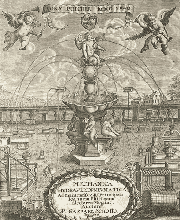|

Gaspar Schott, Mechanica hydraulico-pneumatica,
Würzburg 1657, title-page.
|
Except for the date and the place
of birth (Königshofen, near Würzburg), nothing is known
of his origins and childhood. He entered the Society of Jesus in 1627,
and studied at the university of Würzburg, under the tutelage
of Athanasius Kircher. In 1631, he left Germany, and after various
wanderings, settled in Palermo, where he stayed for 20 years. In 1652,
he was sent to Rome, and was able to reestablish his scientific partnership
with his master, Kircher. Three years later, he moved back to Germany,
first to Mainz, then to Würzburg, where he taught mathematics
and physics until his death.
Schott is particularly famous as the author
of the Mechanica hydraulico-pneumatica (1657), which contains
some of the first descriptions of the experiments on the vacuum, amongst
which is the extremely famous von Guericke experiment. Gathering together,
in a dense web of correspondence, reports and opinions of the most
important savants (von Guericke, Huygens, Boyle), he made a
noteworthy contribution to the diffusion of the most advanced knowledge
of pneumatics (he was, for example, the first man in Germany to provide
news of Boyle's studies on the air-pump).
On the theoretical level, Schott claimed
that the experiments of von Guericke, Torricelli and Boyle had not
produced real vacuums, because the space freed from air was in fact
filled with ether, a more impalpable and refined matter. Nevertheless,
he recognised that the effects which had traditionally been ascribed
to the horror vacui were in fact produced by the pressure and
elasticity of air.
|

